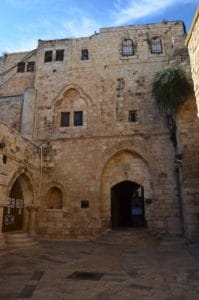Last updated on .
Our visit to Mount Zion started with a walk through the complex, following signs to the building housing King David’s Tomb and the Cenacle. King David’s Tomb is on the ground floor while the Cenacle is on the upper floor. This entry covers King David’s Tomb only.
After walking down from the Cenacle, we visited King David’s Tomb. A Sephardi synagogue established in 1948 sits just outside the entrance.

Recent History
King David’s Tomb was considered Israel’s holiest religious site during Jordan’s annexation of the West Bank and Jerusalem, from 1948 to 1967. Jewish pilgrims were forbidden entry to the Old City at that time. Instead, they would climb to the roof of the building, above the Cenacle, to pray and view the Temple Mount.
Men’s Section
There are separate sections for both men and women. I entered the men’s section, where kippahs are provided to all visitors.
The men’s section contains a library and benches, just outside the entrance to the room containing the sarcophagus of King David.
When the building served as a mosque, the sarcophagus was draped in an Islamic silk cloth. Ever since the tomb was converted to a synagogue in 1949, the sarcophagus has been covered in cloths with symbols and Hebrew text.
Authenticity
Historically, Mount Zion wasn’t regarded as the tomb of David until at least the 9th century. Most archaeologists don’t consider it to be authentic, and the sarcophagus has never been opened to analyze the remains inside.